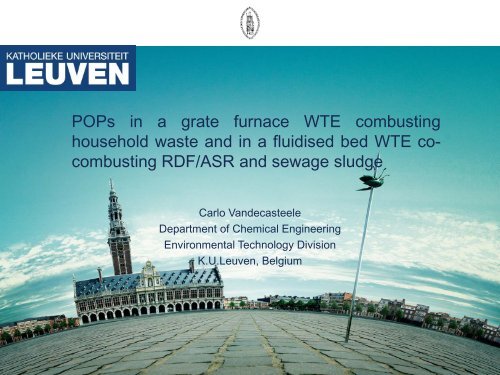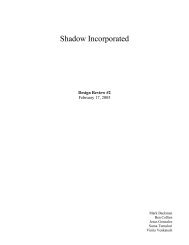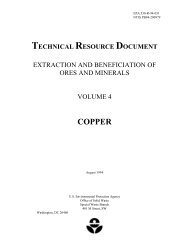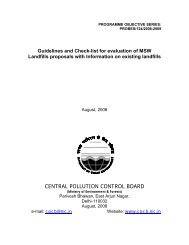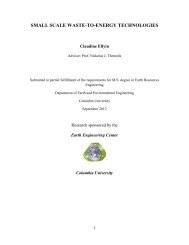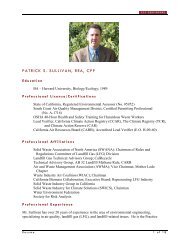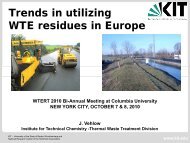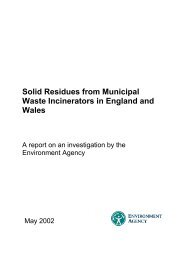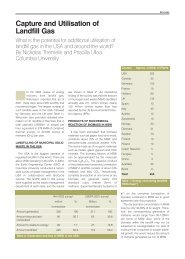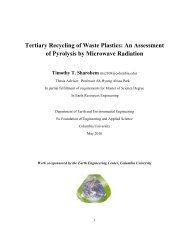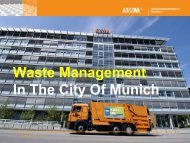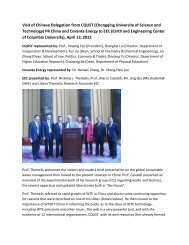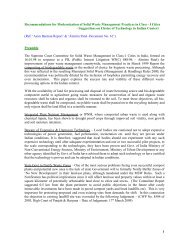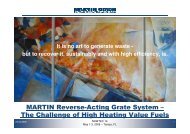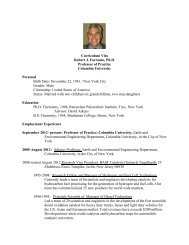Prof. Carlo Vandecasteele
Prof. Carlo Vandecasteele
Prof. Carlo Vandecasteele
Create successful ePaper yourself
Turn your PDF publications into a flip-book with our unique Google optimized e-Paper software.
POPs in a grate furnace WTE combusting<br />
household waste and in a fluidised bed WTE cocombusting<br />
RDF/ASR and sewage sludge<br />
<strong>Carlo</strong> <strong>Vandecasteele</strong><br />
Department of Chemical Engineering<br />
Environmental Technology Division<br />
K.U.Leuven, Belgium
Introduction<br />
At the division of environmental technology:<br />
– 20 years of research collaboration with INDAVER NV, major<br />
waste treatment company in Belgium, with installations for<br />
recycling, incineration, disposal of waste at 6 locations<br />
– Research<br />
• Leaching behavior of heavy metals, oxyanion forming elements in<br />
incinerator residues<br />
• Solidification/stabilisation<br />
• Treatment of residues in view of landfilling, recycling<br />
• Formation and environmental impact of PCDD/Fs and other POPs in<br />
waste incinerators
Grate furnace incineration of<br />
municipal waste<br />
• Indaver N.V., Doel, Antwerp grate furnace incinerator for<br />
MSW (non-recyclable, non-hazardous, not selectively<br />
collected fraction of household waste), comparable<br />
industrial waste, and wastewater treatment sludge<br />
• Three grate furnace lines,<br />
in total 400.000 ton/year<br />
• Important aspects<br />
– WTE<br />
– Careful monitoring and control of air pollution<br />
– Recycling of bottom ashes
Indaver grate furnace incinerator
Indaver grate furnace incinerator<br />
• In boiler superheated steam (40bar, 400°C) produced<br />
– Supplied directly to neighbouring industry<br />
– Used in turbine driven generator to generate electricity<br />
– Gross energy yield: 50.2 %, net: 40.8%<br />
• Residues<br />
– Bottom ash wet treated,<br />
• Metals removed, recycled<br />
• Granulates: road construction, embankment...<br />
• leaching of heavy metals!<br />
– Fly ash and APC residu<br />
• solidification/stabilisation<br />
• landfill
Indaver grate furnace incinerator<br />
• The flue gases are sampled every 2 weeks, for 14 days<br />
using sampling equipment of AMESA type, according to<br />
EN 1948-1 standard<br />
• Subsequently POPS determined by accredited lab<br />
according to EN 1948-2 standard: PCDD/Fs, PCBs,<br />
PAHs, HCB...
PCDD/Fs EMISSIONS for GRATE FURNACES, 2004<br />
0.12<br />
0.12<br />
0.1<br />
0.1<br />
dioxin result (ngTEQ/Nm³)<br />
0.08<br />
0.06<br />
0.04<br />
Below limit value<br />
Average 2004 0.019 ng TEQ/Nm3<br />
Annual emission 0.05 g TEQ, negligible to<br />
overall emission of Flanders of about 80 g TEQ<br />
0.08<br />
0.06<br />
0.04<br />
0.02<br />
0.02<br />
0<br />
0<br />
January<br />
February<br />
March<br />
April<br />
May<br />
June<br />
July<br />
sampling month<br />
August<br />
September<br />
October<br />
November<br />
December<br />
Continuous sampling upper Discontinuous measurement upper LIMIT
PCDD/F and PCB deposition (pgTEQ/m² day) a<br />
few km from incinerator<br />
30<br />
25<br />
20<br />
15<br />
10<br />
Deposition (pgTEQ/m² day)<br />
No limit values for PCDD/Fs and PCB deposition , but VMM<br />
proposed informal system:
Indaver grate furnace incinerator<br />
• POPs not only measured in flue gases, but also in:<br />
– Bottom ash<br />
– Boiler ash<br />
– Flue gas cleaning residu<br />
• Answer question: is incinerator a POP source or sink?<br />
• Methodology developed, to compare weighed sum of<br />
input POPs with weighed sum of output POPs<br />
• NON-CANCER EFFECTS<br />
Minimal risk dose (MRD) for non-carcinogenic effects of chronic oral<br />
exposure (when available), is used to weigh in- and output<br />
Weighing factor = 1/MRD<br />
• CANCER EFFECTS<br />
Potency factor (slope of linear part of (oral) dose-response curve) ) is used to<br />
weigh in- and output<br />
Weighing factor = Potency factor
Input/output ratios<br />
Grate<br />
furnace<br />
MSW<br />
All output fractions<br />
Noncancer<br />
Only flue gas<br />
Cancer Non-cancer Cancer<br />
0.3 – 1.8 0.1 – 1.0 200 – 1 000 30 - 300<br />
If all output fractions are considered, weighted input is comparable to<br />
output
Fluidised bed WTE co-combusting<br />
RDF/ASR and sewage sludge<br />
• Sleco operates FBC at Indaver site, close to grate<br />
furnace incinerator<br />
• Circulating fluidised bed, largest FBC in Europe for<br />
this purpose<br />
• Traditional fuel: high calorific RDF from MBT (70%)<br />
and wastewater treatment (WWT) sludge (30%). In<br />
2008<br />
– 313x10 3 ton of RDF (~70%) and 134x10 3 ton of WWT (~30%)<br />
sludge incinerated<br />
– 250x10 3 MWh electricity produced<br />
• 5-day trial<br />
– Fuel: 25% RDF, 25% ASR, 50% WWT sludge<br />
– inputs and outputs sampled<br />
– PCDD/Fs (dirty 17), co-planar PCBs (12), PCBs (7
Sleco FBC<br />
250x10 3 MWh electricity generated in 2008<br />
Inputs<br />
Outputs<br />
910 °C, 2 s, 6% O 2 excess (freeboard)
Sleco FBC: waste input<br />
• RDF is one of the remaining fractions of MBT of MSW<br />
• Contains mainly plastics, paper and dried organic<br />
material<br />
+/- 10 MJ/kg<br />
1x1cm
Sleco FBC: waste input<br />
• Sludge from industrial and municipal biological wastewater treatment<br />
– Mixture of dewatered and digested sludge, average dry matter<br />
content of 24%<br />
– +/- 2 MJ/kg
Sleco FBC: waste input<br />
• ASR considered is the fraction remaining after a dismantled car is<br />
shredded and ferrous, non-ferrous are separated<br />
– Contains 50% combustibles (PU-foam, plastic fibres and foil) and 50%<br />
inert materials (sand, small stones, iron and rust)<br />
– +/- 19 MJ/kg<br />
1x1cm
Sleco FBC: waste input<br />
Batteries, fuel,<br />
tyres,<br />
engine,...<br />
8-40%<br />
Light fraction<br />
Further<br />
treatment<br />
ELV<br />
100%<br />
Depollution<br />
and<br />
dismantling<br />
Shredder<br />
Heavy ASR<br />
Nonferrous<br />
metal<br />
separation<br />
Magnet<br />
Non-ferrous<br />
metals<br />
1-5%<br />
Ferrous metals<br />
35-65%
Sleco FBC: waste input<br />
• EU Directive 2000/53/EC implies a “reuse and recovery”<br />
rate for ELVs of 95% (reuse and recycling 85%) by 2015<br />
• In Belgium, in 2008 “reuse and recovery” rate was 90%<br />
(in EU-15 78%)<br />
• One option to achieve 95%: increase energy recovery by<br />
incineration of ASR, actually sent to landfill, in FBC<br />
• Will this increase POP output?
RDF<br />
Sludge<br />
Sleco FBC: input waste<br />
PCDD/Fs<br />
pg TEQ/g dw<br />
0.954 –<br />
3.92<br />
0.591 –<br />
3.92<br />
Dioxin-like<br />
PCBs a<br />
pg TEQ/g dw<br />
ASR 242 - 329 481 - 631<br />
Total input coincineration<br />
(25% ASR,<br />
25% RDF, 50% sludge),<br />
kg/year<br />
PCBs b<br />
ng/g dw<br />
1.57 – 6.11 170 - 620<br />
PAH c<br />
ng/g dw<br />
5,300 –<br />
8,400<br />
DEHP<br />
µg/g dw<br />
Mass flow<br />
Normal<br />
feed<br />
ton dw /year<br />
Mass flow<br />
Trial<br />
ton dw /year<br />
313,185 223,704<br />
2.36 – 2.37 130 - 380 340 - 740 134,222 111,852<br />
13,000 –<br />
15,000<br />
37,000 –<br />
140,000<br />
2,900 –<br />
8,300<br />
(2.73 – (5.45 – (1.51 – (4.81 – (3.24 –<br />
3.80)x10 -2 d 7.18)x10 -2 d 1.86)x10 3 16.8)x10 3 9.28)x10 5<br />
~ 100x<br />
111,852<br />
Total input usual waste<br />
feed (70% RDF, 30%<br />
sludge), kg/year<br />
(3.78– (8.08 – (6.4 – (1.71 –<br />
13.8)x10 -4 d 22.3)x10 -4 d 20.2)x 10 1 2.73)x10 3<br />
• ASR contains more POPS<br />
• PCDD/F, dioxin-like PCB, and PCB input about 100 times higher during coincineration<br />
of ASR<br />
• Will POP output increase?
Sleco FBC: output<br />
PCDD/Fs<br />
pg TEQ/g dw<br />
Dioxin-like<br />
PCBs a<br />
pg TEQ/g dw<br />
PCBs b<br />
ng/g dw<br />
PAH c<br />
ng/g dw<br />
Mass flow<br />
ton dw /year<br />
Incineration of 25% ASR, 25% RDF and 50% sludge<br />
Flue gas 6.7 d 0.649 d n.d 786 e 2,278,031 f<br />
Fly and boiler ash 23.0 – 205<br />
0.004 –<br />
0.567<br />
4.2 – 4.8 n.d. 52,546<br />
Bottom ash<br />
n.d – 0.0101 -<br />
0.00078 0.0169<br />
n.d. 10 - 110 38,502<br />
Flue gas cleaning residue 797 – 1,420 14.8 – 25.2 3.8 – 4.3 n.d. - 12 12,704<br />
Total output (kg/year)<br />
(1.13 – (1.90 – (2.69 –<br />
2.88)x10 -2 g 3.56)x10 -4 g 3.07)x10 -1 2.05 – 4.79<br />
Incineration of usual waste feed (70% RDF and 30% sludge)<br />
Flue gas 4 - 12 d 3.0 d 23 e 7,350 e 2,278,031 f<br />
Fly and boiler ash 30.5 n.d. n.d. n.d. 52,546<br />
Bottom ash 0.0412 0.0216 n.d. 270 25,909<br />
Flue gas cleaning residue 980 11.9 n.d. 36 12,704<br />
Total output (kg/year) 1.41x10 -2 g 1.59x10 -4 g 5.24x10 -2 2.42x10 1<br />
• PCDD/F, dioxin-like PCB, outputs during trial comparable or slightly higher<br />
than for “usual” feed<br />
• PCB output during trial is about 10 times higher<br />
• PAH output during trial is about 10 times lower
Sleco FBC: input/output ratios<br />
PCDD/Fs Dioxin-like PCBs PCBs PAHs<br />
Incineration of 25% ASR, 25% RDF and 50% sludge<br />
Total input/output (flue gas) 1,780 – 2,490 36,900 – 48,600 n.d. 2,680 – 9,360<br />
Total input/total output 0.95 – 3.35 150 - 380 4,900 – 6,900 1,000 –8,200<br />
Incineration of usual waste feed (70% RDF and 30% sludge)<br />
Total input/output (flue gas) 14 - 150 120 - 330 1,200 – 3,900 100 - 160<br />
Total input/total output 0.03 – 0.1 5 - 14 1,200 – 3,900 70 - 110
Sleco FBC: conclusions<br />
Due to higher POP concentration in ASR, POP<br />
concentration in input waste was significantly higher<br />
during the trial with ASR, than with the usual feed<br />
POP concentration in the outputs was comparable (or<br />
lower), except for PCBs.<br />
Input/output ratio for POPs in co-incineration of ASR is<br />
thus higher, more advantageous, than with the usual<br />
feed<br />
PCDD/Fs, dioxin-like PCBs and PCBs in input are<br />
destroyed, but new POPs are formed during cooling<br />
of flue gases (different fingerprints)
Sleco FBC: with weighing of POPs<br />
Weighing with (1/MRD)<br />
Weighing with potency factor<br />
Incineration of 25% ASR, 25% RDF and 50% sludge<br />
Total input/output (flue gas) 9,700 – 13,000 1,800 -21,500<br />
Total input/total output 5.6 - 19 9.1 -127<br />
Incineration of usual waste feed (70% RDF and 30% sludge)<br />
Total input/output (flue gas) 120 - 740 40 - 420<br />
Total input/total output 0.31 – 0.97 3.2 - 14
Sleco FBC: with weighing of POPs<br />
When masses of POPs were weighed and aggregated, the<br />
total POP input was higher during co-incineration of<br />
ASR than for normal feed, but POP output only showed<br />
limited increase<br />
Input/output ratios more advantageous with ASR than with<br />
usual feed<br />
POPs in the waste were destroyed and formation of new<br />
POPs during cooling of gases is to large extent<br />
independent from POP concentration in incinerated<br />
waste
References<br />
• C. <strong>Vandecasteele</strong>, G. Wauters, S. Arickx, M. Jaspers, T. Van<br />
Gerven, integrated municipal solid waste treatment using a grate<br />
furnace incinerator: The Indaver Case, Waste Management, 27<br />
(2007) 1366<br />
• J. Van Caneghem, C. Block, A. Van Brecht, G. Wauters, C.<br />
<strong>Vandecasteele</strong>, 2009, Mass balance for POPs in hazardous and<br />
municipal solid waste incinerators. Chemosphere 78 (2010) 701<br />
• J. Van Caneghem,C. Block, I. Vermeulen, A. Van Brecht, P. Van<br />
Royen, M. Jaspers, G. Wauters, C. <strong>Vandecasteele</strong>, Mass balance<br />
for POPs in a real scale fluidized bed combustor co-incinerating<br />
automotive shredder residue, J. Hazardous Materials, 181 (2010)<br />
827


